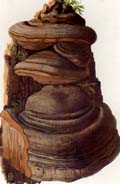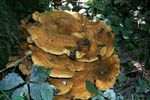 Key to Gilled Mushrooms Key
Key to Gilled Mushrooms KeyThis is a key to gilled mushrooms, that is, mushrooms having a definite cap with a fertile surface consisting of gills. The fruiting body usually also has a stem, although that may be lateral or absent (usually, then, the mushroom is growing from wood). You can use this key to identify mushrooms that you find.
 Polyporaceae Family
Polyporaceae FamilyFertile surface usually a layer of vertical tubes, of which the mouths are visible as pores on the underside of the cap or shelf.
Fruiting bodies usually tougher or harder than the "normal" gilled mushrooms, being leathery, corky, or woody. But they can be quite tender while actively growing
Once grown, they do not decay easily, remaining on the substrate for months or years
They often grow on wood, although a few are terrestrial (even those are usually growing on buried wood)
Fruiting body is usually a flat shelf, or hoof-shaped, protruding directly from the substrate, although sometimes it may have a short stalk.
Some forms never grow away from the substrate at all, so that all that is visible of the fruiting body are the pores.
Sometimes the pores are so minute that the fertile surface seems solid, until you look closely
 Terrestriopolypore Subfamily
Terrestriopolypore SubfamilyGrowing on ground
 Medium Terrestriopolypore Tribe
Medium Terrestriopolypore TribeCap variable in size, but averaging 3-4"
Flesh soft, flexible, though it may dry hard and brittle
 Shortoporus Subtribe
Shortoporus SubtribeCap and stipe fleshy and substantial, flexible
Pores very short: 1-5 mm
Pore surface pale
Fruiting bodies irregular, often slightly lobed, stalk often off-center
Fruiting bodies sometimes clustered or compound, but more often singly or in troops
Albatrellus Genus S. F. Gray

Diagnosis
- Lightly colored - - at best pastel-ish.
-
Flexible flesh that often dries hard and brittle
-
Cap usually about 4" across, although their size is quite variable
- The spores are smooth and ellipsoid, which is the best way to distinguish the genus from Boletopsis. Macroscopically, you have to use cap color
Comments
R. L. Gilbertson & Ryvarden (1986 - 1987) felt that Albatrellus was very close to the Hydnums - - both species are mycorrhizal, have fleshy fruiting bodies with inflated hyphae and smooth, ellipsoid spores. In fact, they felt that if it wasn't for the configuration of the hymenophore, there wouldn't be any way to tell the two genera apart. But so far, "DNA analysis" has failed to find any close relationship between the taxa
Narrow down your identification:
 Albatrellus caeruloporus
Albatrellus caeruloporusUp to 2 1/4" across; slate blue to deep blue when fresh; drying greyish brown to reddish orange
Usually under hemlock
 Albatrellus confluens
Albatrellus confluensCap 2-6" across, cap and stem apricot buff with reddish tones
Pore surface creamy, drying pale pinkish tan
Often growing in fused masses
Smell pleasant, cabbage-like
Taste bitter
Albatrellus cristatusCaps up to 5" across; yellowish olive to greenish brown to brown; rough
Pores a much paler version of cap color
 Albatrellus ovinus
Albatrellus ovinus2-6" wide, buff or tan all over, with perhaps tinges of some other colors.
Some of my sources say that this, too, acquires red tones on drying. That may be just the result of a broad species concept
 Albatrellus peckianus
Albatrellus peckianusYellow pore surface
Yellowish tinge to the rest of the fruiting body






 Key to Gilled Mushrooms Key
Key to Gilled Mushrooms Key Polyporaceae Family
Polyporaceae Family Shortoporus Subtribe
Shortoporus Subtribe
 Albatrellus caeruloporus
Albatrellus caeruloporus Albatrellus confluens
Albatrellus confluens Albatrellus ovinus
Albatrellus ovinus Albatrellus peckianus
Albatrellus peckianus




